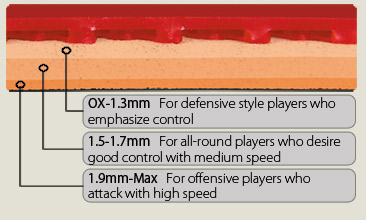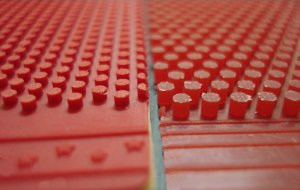
| Main page | What is table tennis? | Physics and Mathematics | Empirical Observations of Spin |
When using a paddle, there are three basic parts that establish it: The blade, the sponge, and the rubber.

When it comes to paddles, there are two components to be aware of:
1. The thickness of the sponge
2. The rubber
Sponge Thickness
The thickness of the sponge creates a spectrum of defense versus offense. The general rule is that a thicker sponge would mean more power, and a thinner sponge would mean more control.

Rubber
In table tennis, there are three particular rubbers: inverted (or smooth), short pips, and long pips.
Pips, or pimples, are the little nubs that protrude from a single side of a rubber. Rubbers can have short pips or long pips.
Short pips usually have use in close-to-table and reactive counter play styles. This is because it generates a lot less spin than a smooth surface rubber and also does well in absorbing spin. It can be used for a defensive play style. It is known primarily for bringing back the old-fashioned "classic" play of the pre-spin table tennis.
Long pips have extra long pips protruding from the rubber. The way it is used in play is by counteracting and reversing the spin of the opponent. The longer pips also enact unpredictability in its spin. It makes the ball "wobble" and alter its trajectory. This makes it difficult for players who are unable to read spin. Long pips are difficult to play offensively, so players generally use it on a single side of the paddle.

